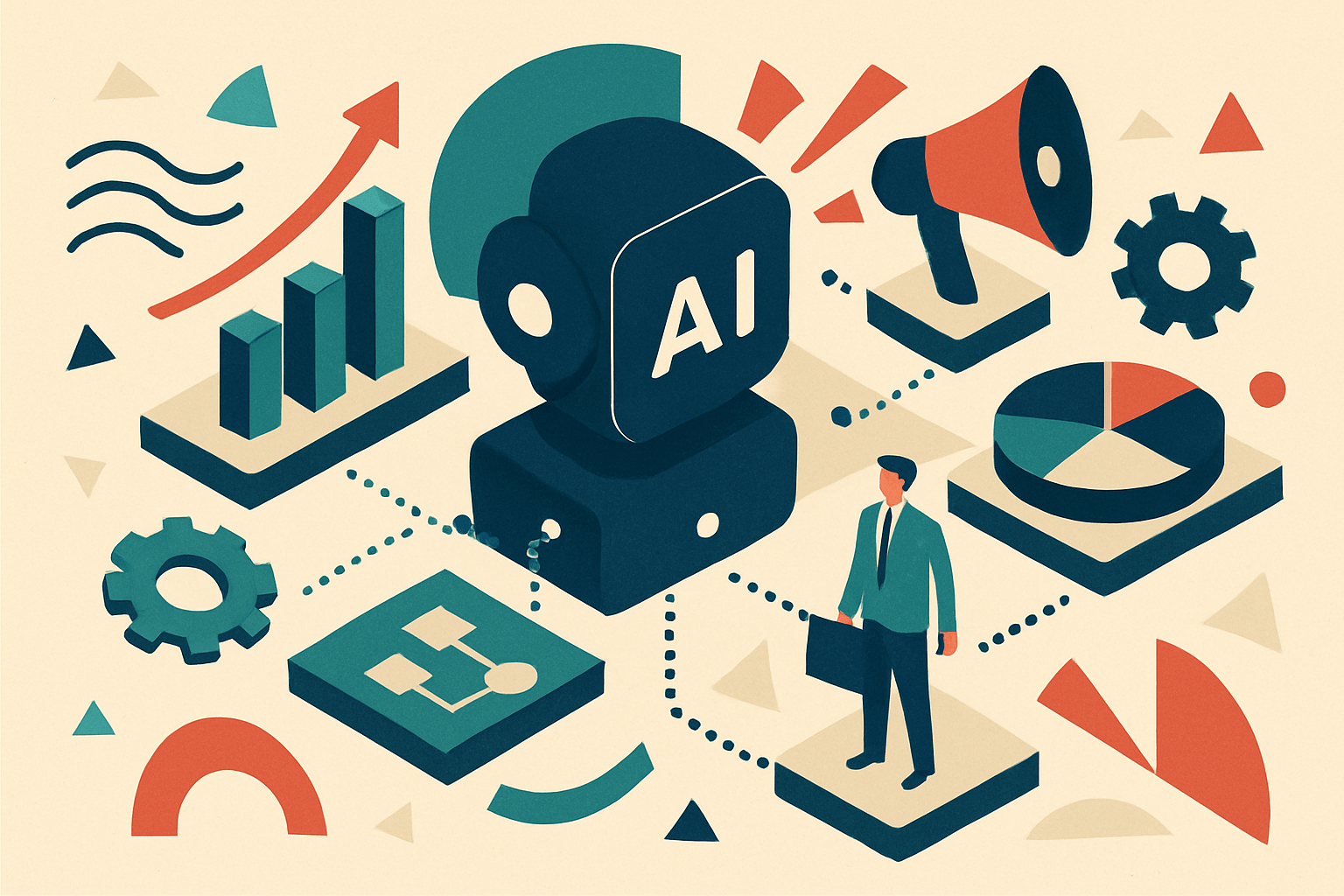
Harnessing AI-Infused Capabilities for Business Disruption
AI-Infused Business Innovation
Discover the potential of AI to revolutionize your marketing strategy
Understanding AI-Infused Capabilities and Disruption
AI-infused capabilities power the next wave of disruptors by fundamentally altering how businesses operate and engage with their audiences. This transformation is driven by the integration of advanced technologies into marketing and operational strategies. Businesses are leveraging AI to not only enhance efficiency but also to build more personalized customer experiences. As consumer expectations evolve, brands must harness these technologies to stay competitive and relevant. Understanding how AI-infused capabilities can disrupt conventional business models is essential for creative directors and marketing leaders alike.
The digital landscape is evolving rapidly, and the influence of AI on tech trends is omnipresent. Companies across various industries are adopting AI to bolster their marketing innovation, streamline operations, and generate insights through data analytics. For instance, an e-commerce platform that utilizes AI algorithms can predict which products to recommend based on customer behavior, significantly enhancing conversion rates. Moreover, AI can automate repetitive tasks, freeing up teams to focus on strategic initiatives and creative brainstorming.
However, to truly capitalize on AI-infused capabilities, businesses must shift their mindset towards embracing disruption. Approaching disruptions as opportunities rather than threats allows for more innovative thinking and problem-solving. This proactive stance will help businesses adapt more swiftly to the ever-changing landscape of customer demands and competitive pressures. Understanding these dynamics can be the difference between leading the market and playing catch-up.
To disrupt a business model means to introduce a product, service, or way of operating that fundamentally changes how value is created, delivered, or captured in an industry—often in a way that challenges or even displaces established players.
It’s not just competition; disruption reshapes expectations, pricing, accessibility, or delivery so significantly that incumbents either adapt or risk becoming obsolete.
Key Aspects of Business Model Disruption
- New Value Proposition
Offering something customers didn’t know they needed, or delivering it in a simpler, cheaper, or more accessible way.
Example: Netflix moving from DVD rentals to streaming made on-demand video mainstream. - Redefining Distribution or Access
Changing how customers access products/services.
Example: Uber disrupted taxis by removing dispatch systems and connecting riders directly with drivers via app. - Cost Structure Shifts
Leveraging technology, automation, or alternative infrastructure to reduce costs.
Example: Dollar Shave Club undercut big razor brands with subscription pricing and direct-to-consumer delivery. - Revenue Model Change
Turning one-time purchases into recurring revenue, or free offerings supported by ads/data.
Example: Spotify offering free ad-supported streaming alongside paid subscriptions disrupted music sales. - Democratization of Access
Making something available to a wider audience that was once niche, expensive, or exclusive.
Example: Canva disrupted professional design tools by making simplified design accessible to non-designers.
Practical Steps to Implement AI in Your Business Strategy
Taking action on incorporating AI into your business strategy requires structured planning and execution. Start with a comprehensive assessment to identify areas within your processes that can benefit from AI tools. Evaluate your existing technologies and consider how AI can enhance data analysis, customer engagement, or efficiency in operations. For example, implementing AI chatbots for customer service can reduce response times and increase customer satisfaction.
Next, consider forming cross-functional teams that can faithfully pilot AI initiatives. This could include representatives from your marketing, tech, and customer service sectors. By fostering collaboration, you encourage diverse perspectives that can lead to innovative applications of AI. Identify potential AI solutions that align with your business objectives and conduct feasibility studies before full-scale implementation.
Finally, develop a feedback loop that allows for continuous evaluation of AI-led initiatives. This iterative process not only provides insights into their effectiveness but also uncovers areas for improvement. Ensure that you establish KPIs (Key Performance Indicators) that will help measure success, such as customer engagement metrics or conversion rates. Without these measures, it may be difficult to assess whether your AI integration is leading to frictionless operations or improved customer experiences.
Framework and Checklist for AI Integration
To streamline the process of integrating AI into your business strategy, follow this simple framework:
- Identify Objectives: Clearly define what you want to achieve with AI integration. Are your goals customer-centric, operational efficiency-based, or both?
- Research AI Solutions: Explore various AI applications that fit your objectives. This can range from CRM tools to automated analytics platforms.
- Develop a Roadmap: Create a strategic roadmap that outlines each phase of your AI implementation, including short-term and long-term goals.
- Pilot Programs: Initiate pilot projects to test the viability of the selected AI solutions before widespread deployment.
- Continuous Review: Foster a culture of continuous improvement by regularly reviewing the performance of your AI solutions.
Keeping this checklist in mind will ensure a structured approach, helping you to focus your efforts effectively as you embark on this journey.
Case Studies: Success with AI-Infused Capabilities
One real-world example of successful AI integration is that of a leading online retailer. By employing machine learning algorithms to analyze customer purchasing behaviors, they were able to enhance their recommendation engine. With these tailored suggestions, they reported a 20% increase in sales in their first quarter post-implementation. Additionally, implementing AI-driven inventory management minimized stock discrepancies and optimized order fulfillment, demonstrating considerable gains in operational efficiency.
An anonymized example comes from a mid-sized marketing agency that integrated AI into their content generation strategy. By leveraging AI tools to analyze trending topics and consumer sentiment, they could produce highly relevant content that resonated with their target audience. This approach not only improved client satisfaction but also led to a 30% boost in engagement metrics across their campaigns.
Challenging Misconceptions Around AI in Business
A common misconception is that AI will replace human jobs and dehumanize business interactions. However, this viewpoint overlooks the value of AI as a tool for enhancing human capacity rather than replacing it. AI excels in sorting through vast datasets, identifying patterns, and performing repetitive tasks. This allows human employees to focus on what they do best: creativity, strategy, and relationship building. For example, marketers equipped with AI insights can craft more personalized campaigns without getting bogged down by data analysis.
Measuring Success: KPIs and Common Pitfalls
To evaluate the effectiveness of your AI initiatives, consider implementing key performance indicators (KPIs) that align with your strategic goals. For marketing-oriented projects, this may include metrics such as conversion rates, customer satisfaction scores, and ROI from AI-driven campaigns. For operational improvements, focus on efficiency metrics like turnaround time, cost savings, or error reduction associated with AI automation.
Equally important is the documentation of your AI processes. Create living playbooks that capture not only the technical setup, such as data sources, workflows, and integrations, but also the rationale behind key decisions. This ensures transparency, facilitates troubleshooting, and makes it easier to scale solutions across teams. Proper documentation also creates a knowledge base for onboarding new employees or evaluating future upgrades.
Beyond documentation, invest in training programs to help employees understand how to implement, use, and optimize AI systems. Training should cover both the tactical aspects, such as how to operate specific tools or workflows, and the strategic perspective, such as how AI aligns with business goals and customer needs. By developing team confidence and competence, you reduce resistance to change and empower staff to spot new opportunities for automation and optimization.
Common pitfalls to be aware of include neglecting the necessary cultural shift required to embrace AI fully. Without proper documentation and training, organizations risk creating “black box” systems understood only by a handful of people, which leads to bottlenecks and knowledge silos. In addition, rushing into AI implementation without thorough evaluation and planning can result in disjointed efforts that fail to achieve meaningful outcomes. Recognizing these potential challenges and proactively addressing them with documentation, KPIs, and training helps ensure your AI initiatives remain sustainable and impactful over time.
Here are specific key ways a business can use AI to disrupt its capabilities.
1. Product & Service Reinvention
- AI-driven personalization: Instead of selling one-size-fits-all, businesses deliver hyper-personalized recommendations, services, or bundles.
Example: Retailers moving from static catalogs to AI-curated “stores” unique to each shopper. - AI-powered creative output: Design, video, or copy generated on-demand reduces reliance on traditional production cycles.
Example: Agencies offering subscription-based “always-on creative,” replacing project-based models.
2. Cost Structure Disruption
- Automation of repetitive tasks: Replace manual design, scheduling, reporting, or customer service with AI-driven systems.
Result: Shifts labor costs into scalable technology costs, enabling new pricing models (e.g., flat-fee unlimited design). - Dynamic pricing models: AI can analyze demand, competitors, and inventory in real time to optimize revenue.
Airlines and hotels already use this, but AI allows even small businesses to compete at that level.
3. Distribution & Access
- Conversational commerce: AI chatbots or voice agents become the “storefront,” replacing websites or apps for many interactions.
- On-demand production: AI paired with 3D printing or just-in-time manufacturing reduces inventory risk, changing how goods are distributed.
4. Customer Relationship Disruption
- Predictive support: AI predicts customer needs before they contact support, changing the model from reactive to proactive service.
- AI-driven community engagement: Automated yet human-like brand personas can scale customer interaction, disrupting how loyalty and retention are built.
5. New Revenue Streams
- Data monetization: Companies use AI to turn operational data into insights/products for partners or industries.
- Subscription transformation: Physical products paired with AI-powered dashboards or services shift one-off sales into recurring models.
Example: A fitness equipment brand selling hardware plus an AI coach subscription, disrupting the gym membership model.
Next Steps for AI-Infused Capabilities Power The Next Wave Of Disruptors
Now that you understand the transformative potential of AI-infused capabilities, it’s crucial to take action. Begin by assessing your current business processes and identifying opportunities where AI could bring value. Collaborate with your teams to brainstorm innovative applications, test pilot programs, and create success metrics tailored to your objectives. The time to harness AI is now; your business’s future depends on embracing these tech trends. Don’t wait—implement these insights and prepare to lead in this exciting new era of disruption.


